On arrival at Hosea Kutako International Airport, after clearing Customs and Immigration you will be met and transferred to your light aircraft flight to the Sossusvlei area.
The flight will take you over the central highlands of Namibia before descending after the escarpment and on over Namib Desert to land at the Sossusvlei Desert Lodge airstrip.
Upon arrival you will be met by your local guide who will transfer you to andBeyond Sossusvlei Desert Lodge where you will stay for two nights. The afternoon can be spent enjoying many of the activities offered by the lodge.
The &Beyond Sossusvlei Desert Lodge is a spectacular design of glass, rock and steel pavilions with a bold geometric structure at the centre. The guest area features floor to ceiling, frameless glass panels that fold away to reveal unobstructed desert vistas and there are various areas in which to relax while enjoying a fine selection of wines. Signature features include a gym, ideally positioned to catch the desert sunrise, and a two-part wellness centre offering a private spa-bath as well as a wet treatment room with its own skylight for early-evening star-gazing. The reserve is one of the world’s few Dark Sky Reserves, and every evening guests are invited to join a resident astronomer at the on-site, world-class observatory. The ten suites offer the sophistication of simplicity, reflecting chic desert-inspired minimalism, and a variety of desert adventures are on offer.
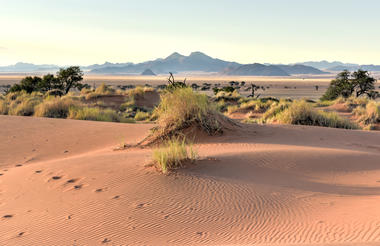
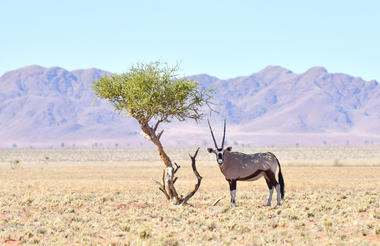
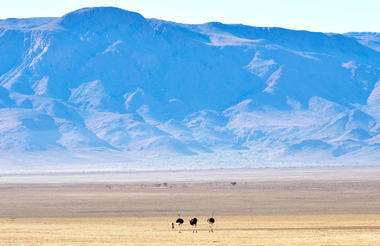
All meals, most drinks, guided nature walks; e-biking; guided quad bike excursions
imported beverages and vintage wines and laundry
This morning you will rise early for a magical excursion into the Namib Naukluft National Park, entering the Park gates at sunrise to capture the dunes whilst the light is soft and shadows accentuate their towering shapes and curves. This area boasts some of the highest free-standing sand dunes in the world.
Your local guide will give you an insight on the formation of the Namib Desert and its myriad of fascinating creatures and plants that have adapted to survive these harsh environs. Once you have explored the areas around Sossusvlei and Deadvlei to your hearts content you can enjoy a picnic in the shade of a camel thorn tree. Return to your lodge in the early afternoon for a late lunch. The rest of the afternoon is at your leisure (from experience, this is usually welcomed after an exhilarating morning in the dunes) or can be spent on another guided scheduled activity within the nature reserve as offered by the lodge.
Sossusvlei: This most frequently visited section of the massive 50, 000 km² Namib Naukluft National Park has become known as Sossusvlei, famous for its towering apricot coloured sand dunes which can be reached by following the Tsauchab River valley. Sossusvlei itself is actually a clay pan set amidst these star shaped dunes which stand up to 300 meters above the surrounding plains, ranking them among the tallest dunes on earth. The deathly white clay pan contrasts against the orange sands and forms the endpoint of the ephemeral Tsauchab River, within the interior of the Great Sand Sea. The river course rises south of the Naukluft Mountains in the Great Escarpment. It penetrates the sand sea for some 55 km before it finally peters out at Sossusvlei, about the same distance from the Atlantic Ocean. Until the encroaching dunes blocked its course around 60, 000 years ago, the Tsauchab River once reached the sea; as ephemeral rivers still do in the northern half of the Namib. Sand-locked pans to the west show where the river previously flowed to before dunes shifted its endpoint to where it currently gathers at Sossusvlei. Roughly once a decade rainfall over the catchment area is sufficient to bring the river down in flood and fill the pan. On such occasions the mirror images of dunes and camel thorn trees around the pan are reflected in the water. Sossusvlei is the biggest of four pans in the vicinity. Another, famous for its gnarled and ghostly camel thorn trees, is Deadvlei which can be reached on foot over 1 km of sand. Deadvlei’s striking camel thorn trees; dead for want of water, still stand erect as they once grew. They survived until about 900 years ago when the sand sea finally blocked the river from occasionally flooding the pan.



All meals, most drinks, guided nature walks; e-biking; guided quad bike excursions
imported beverages and vintage wines and laundry
This morning you will be transferred to the airstrip for your scheduled charter flight to Mowe Bay Airstrip. Upon arrival you will be met and transferred to the Shipwreck Lodge where you will stay for two nights.
The lodge is located in the famous Skeleton Coast Central Concession between the Hoarusib and Hoanib Rivers in the Skeleton Coast Park, only 45 km north of Möwe Bay. The lodge is situated on the southern bank of the Huarusib River Mouth.
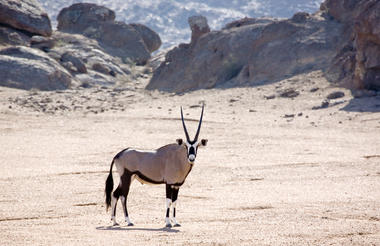
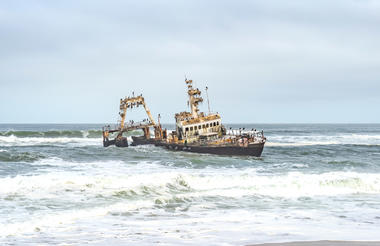
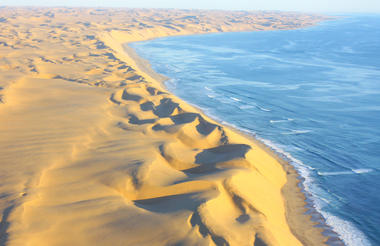
All meals, local beverages, laundry and daily activities, excursions and park entry permit
Laundry
Enjoy a full day of activities.
Möwe Bay Excursions
The dangerous beauty of Skeleton Coast
Either on your way to the lodge from Möwe Bay or returning from the lodge, you will see what is left of the victims of this treacherous coastline: Decaying ships, the remains of a Ventura Bomber and the abandoned Westies Diamond Mine bear witness to the unforgiving nature of this arid landscape. You will also visit the seal colony.
Hoarusib River Excursion
All along the river… Spend your morning exploring the Hoarusib River. Visit the Clay Castles, a striking geological formation. You might even spot the elusive desert-adapted elephants, brown hyenas and lions.



All meals, local beverages, laundry and daily activities, excursions and park entry permit
Laundry
After a leisurely breakfast you are transferred back to the airstrip for your light aircraft flight north up to Onduli Ridge for a two night stay. This flight includes flying over the Namib Sea Sand two shipwrecks, seal colonies along the Atlantic Ocean, abandoned diamond camps and Walvis Bay lagoon and salt works.
Low level flying and visibility of attractions will be weather permitting, and subject to protected land rules such as the bird sanctuary at Sandwich Harbour. A highlight is the flight over the Eduard Bohlen, a German cargo ship that ran aground in 1909 while it was on its way to Table Bay from Swakopmund. Years after the ship ran aground the desert began to encroach on the ocean and the ship that was once stranded in the ocean slowly became stranded in the desert. The wreck currently sits about 500 metres from the ocean, ensuring that it’s the best-preserved shipwreck along Namibia’s Skeleton Coast. You refuel in Swakopmund and afterwards, you continue north to reach the Damaraland-based airstrip where you will be met by your private Ultimate Safaris naturalist guide who will accompany you for the remainder of your safari. Depending in what time you arrive at the camp, the afternoon can be spent enjoying a guided nature drive or walk, or you can simply relax, with time to enjoy sundowners appreciating the unique surroundings of your camp in the Damaraland wilderness.
Damaraland is typified by displays of colour, magnificent table topped mountains, rock formations and bizarre-looking vegetation. The present-day landscape has been formed by the erosion of wind, water and geological forces which have formed rolling hills, dunes, gravel plains and ancient river terraces. It is the variety and loneliness of the area as well as the scenic splendour which will reward and astound you, giving one an authentic understanding of the word 'wilderness'.
Onduli Ridge, named after the resident giraffe of the area, is built at the base of two south facing granite outcrops which are connected by a ridge. This location allows for magnificent views of Namibia’s highest mountain, the Brandberg, to the south and the dispersed cathedral-like granite inselbergs to the north. The six suites are hidden amongst the granite boulders that nestle the camp and the more temperate climate of central Damaraland allows for naturally ventilated suites, partial open-air bathrooms and largely open communal areas. The camp is designed to maximise the views of this most extraordinary landscape and every space becomes a viewpoint whether from the bed, the desk or the bathroom. Louvered shutters can be opened completely, blurring the lines between the indoors and nature, or closed for complete privacy if required. A king size bed cooled by its own ‘climate conditioner’ (Evening Breeze) is also the perfect place for afternoon siestas and the bed can be rolled out onto your private deck for a night under a billion stars as required. The camp exudes character and meticulous attention to detail meeting all requirements, from large rooms to libraries, rain showers, refreshing pool and plenty of places to laze. Food to tantalize the palate after enjoying exceptional activities combines a genuinely unforgettable stay with exceptional quality while blending effortlessly into the natural surroundings.
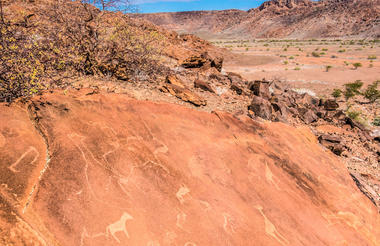
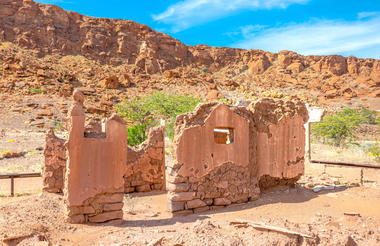

All meals, most drinks and activities
imported beverages and vintage wines and laundry
After an early breakfast you will be treated to an exciting 4x4 excursion along the ephemeral river valleys to explore this remarkable region and to search for game, especially the elusive desert adapted elephants if they are in the area. Damaraland is home to a variety of desert adapted wildlife and hidden desert treasures. You will normally then return to camp for lunch and a well-deserved siesta.
Your guide will arrange to fit in a visit to Twyfelfontein and other nearby attractions at a suitable time in the afternoon if this appeals and you haven’t already been there the previous day, or you can go out with your guide and take a walk into the local area around Camp or enjoy an afternoon e-bike tour. Alternatively, if you prefer, you can stay in to relax and enjoy some well-deserved leisure time in the comforts of the camp.
Desert Adapted Elephant: In habitats with sufficient vegetation and water an adult elephant consumes as much as 300 kg of roughage and 230 liters of water every day of its life. Consider what a herd of them would eat and drink in a week or a month or a year. Finding an African elephant in a desert? Well, yes, and not only elephant, but other large mammals as well, such as black rhinoceros and giraffe.
Their ranges extend from river catchments in northern Kaokoveld as far south as the northern Namib. Apart from the Kunene River, seven river courses northwards from the Ugab provide them with possible routes across the desert, right to the Skeleton Coast. The biggest are the Hoarusib, the Hoanib, the Huab and the Ugab Rivers. Desert adapted elephant in Kaokoland and the Namib walk further for water and fodder then any other elephant in Africa. The distances between waterholes and feeding grounds can be as great as 68 km. The typical home range of a family herd is larger then 2, 000 km², or eight times as big as ranges in central Africa where rainfall is much higher. They walk and feed at night and rest during the day. To meet their nutritional and bulk requirements they browse on no fewer than 74 of the 103 plant species that grow in their range. Not a separate species or even a subspecies, they are an ecotype unique to Namibia in Africa south of the equator, behaviorally adapted to hyper-arid conditions. Elephant in Mali on the southwestern fringe of the Sahara Desert are the only others known to survive in similar conditions.
Twyfelfontein: Strewn over a hillside amongst flat-topped mountains of red sandstone, Twyfelfontein’s boulders and slabs of red sandstone hold some 2, 500 prehistoric engravings that depict wildlife, animal spoor and abstract motifs. It is perhaps the largest and finest collection of petroglyphs in Africa. The engravings show animals such as elephant, giraffe, kudu, lion, rhinoceros, springbok, zebra and ostrich that once used to drink from a fountain at the bottom of the hill. In some cases footprints were engraved instead of hooves or paws. The abstract motifs feature mainly circles. Stone tools and other artifacts found at Twyfelfontein suggest that hunter-gatherers occupied the site over a period of perhaps 7, 000 years. These days a local guide accompanies visitors to showcase the rock art. The engravings lie along two circular routes, one an hour’s climb and the other 40 minutes longer. Twyfelfontein is one of Namibia’s key National Monuments and has recently become a UNESCO World Heritage Site.
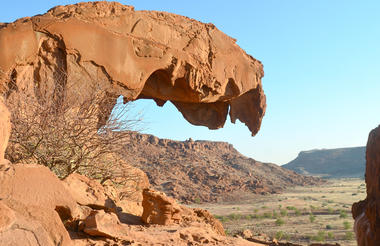
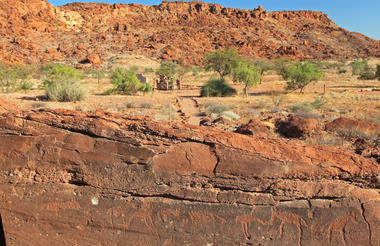
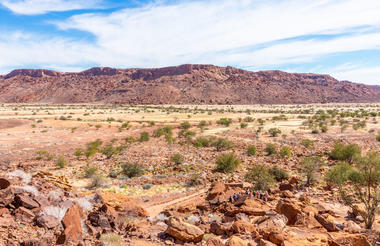
All meals, most drinks and activities
imported beverages and vintage wines and laundry
This morning you will have an early departure from Onduli Ridge as you make your way north deeper into the heart of Damaraland, having a picnic lunch en route. You arrive in time for an afternoon shared game drive on the Ongava Game Reserve with the local camp guide, on shared basis with other camp guests. Arrive at Andersson's At Ongava where you will stay for two nights.
Ongava Game Reserve: The Ongava Game Reserve is effectively a private game reserve, spanning 30, 000 hectares along the south-west border of Etosha National Park. The reserve is home to a wide variety of game including lion, leopard, giraffe, rhino, Hartmann’s mountain zebra, gemsbok (Oryx), kudu, steenbok and much more. The scenery is attractive with large open plains blending into Mopane tree woodlands and granite outcrops.
Anderssons at Ongava: Located just 4.5km from Etosha National Park’s Andersson Gate, Andersson’s at Ongava takes its name from Charles Andersson, the Swedish explorer who first 'discovered' the Etosha Pan with Sir Francis Galton in 1851. Set against a backdrop of the low Ondundozonanandana Mountains, Andersson’s at Ongava is located within the private Ongava Game Reserve which borders the Etosha National Park. The Ongava Game Reserve is typified by white calcrete soils, rocky outcrops and scrub-covered plains which support a rich variety of game such as giraffe, lion, rhino and various antelope species. The Camp overlooks a waterhole where guests can enjoy the interaction of wildlife coming and going throughout the day and night. Central to the design of the new Andersson’s at Ongava is the waterhole and nearby underground photographic hide. Here guests have a water level view of the prolific wild and birdlife on Ongava Game Reserve.
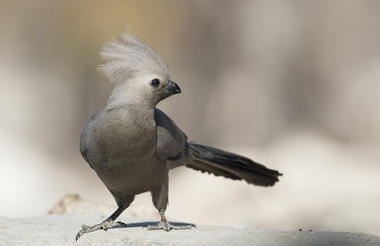
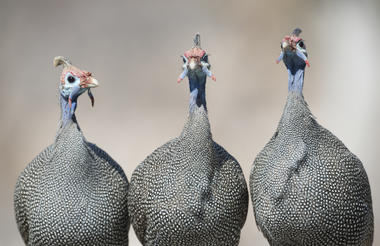
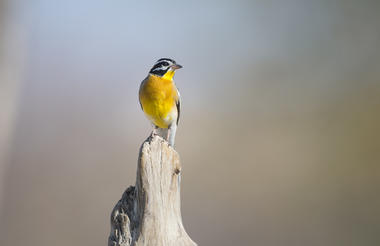
All meals, most drinks and activities
imported beverages and vintage wines and laundry
Today you will be treated to an exciting morning guided game drive into the Etosha National Park, to see more of the wide variety of game and bird species that are to be found there before returning to Ongava Lodge for a late lunch. There is then time to relax by the refreshing swimming pool before you head out again for an afternoon game drive before exiting the park before sunset (either in the park or on the Ongava Reserve as per discussions with your guide).
Alternatively, you can opt to spend the whole day out in the park and either take lunch by the waterhole at the Okaukuejo restcamp or have a picnic while watching game at a particularly productive waterhole in the area. Once you are back, the rest of the evening can be spent game viewing at the camp’s floodlit waterhole while enjoying dinner, and afterwards.
Etosha National Park: Etosha National Park, translated as the ‘Place of Mirages’, Land of Dry Water’ or the ‘Great White Place’, covers 22, 270 km², of which over 5, 000 km² is made up of saline depressions or ‘pans’. The largest of these pans, the Etosha Pan, can be classified as a saline desert in its own right. The Etosha Pan lies in the Owambo Basin, on the north-western edge of the Namibian Kalahari Desert. Until three million years ago it formed part of a huge, shallow lake that was reduced to a complex of salt pans when the major river that fed it, the Kunene, changed course and began to flow to the Atlantic instead. If the lake existed today, it would be the third largest in the world. Etosha Pan is the largest of the pans at 4, 760 km² in extent.
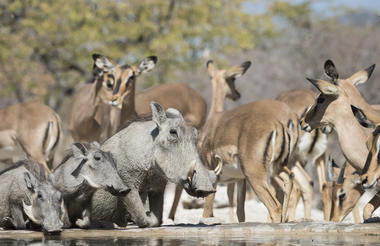
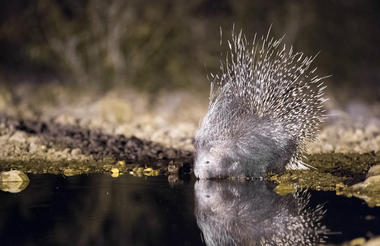

All meals, most drinks and activities
imported beverages and vintage wines and laundry
After breakfast this morning you will make your way south from the Etosha National Park through the small towns of Outjo and Otjiwarongo before stopping at the Okonjima AfriCat Day Centre, a wonderful highlight with which to conclude your safari. Okonjima is home to the AfriCat Foundation, a wildlife sanctuary which focuses on the research and rehabilitation of Africa's big cat. You arrive in time for the late morning departure and tour of the centre. Here you will learn about the function and vision of the AfriCat Foundation and will also get to meet some of the Foundation’s special captive carnivore ambassadors. You enjoy a lunch afterwards.
PLEASE NOTE: There will be no tracking of wild cats on this visit and should that be required an overnight extension should be booked as per the below.
After the excursion and freshening up, the journey continues further south to arrive back in Windhoek in the late afternoon, just as the sun is setting. Upon your arrival in Windhoek you will be transferred to the Windhoek International Airport for your International flight home!
Breakfast



